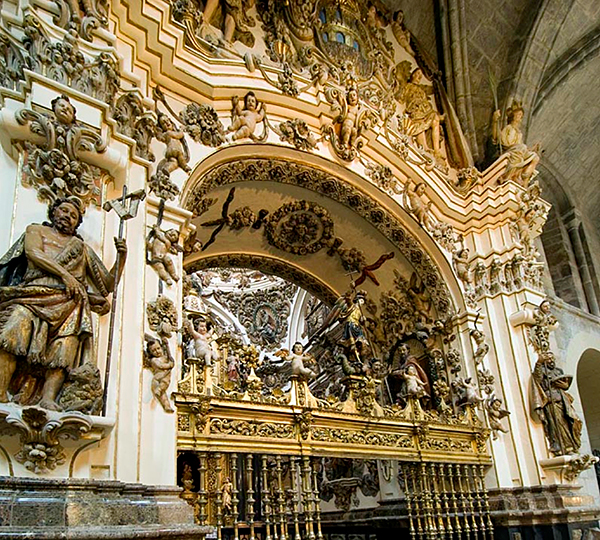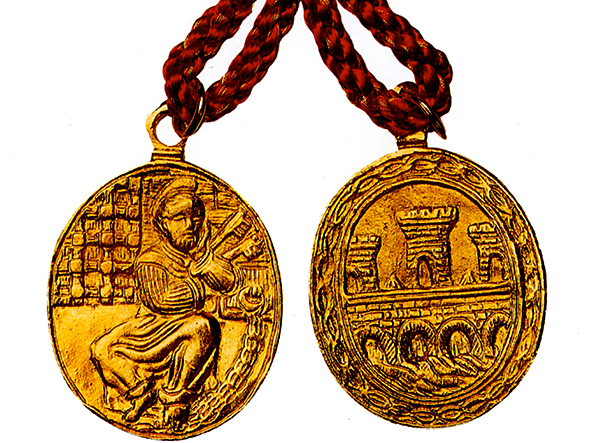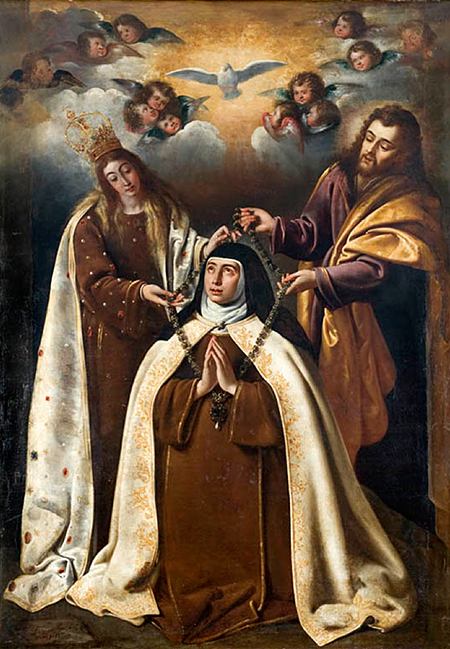24 August
lecture series
FOUR PERSPECTIVES ON THE CULTURAL HERITAGE OF TUDELA
In tune with the times: festivals, vows and patron saints in Tudela
D. Ricardo Fernández Gracia
Chair de Patrimonio y Arte Navarro
In past centuries, when in the face of difficulties and catastrophes, everything was entrusted to Divine Providence and its intercessors, vows to saints became very important. subject The different vows that the towns and villages made to commemorate and honour the saints who had protected them against all kinds of calamities had different fates over the years. Pamplona had numerous vows of different origins, studied by Marcelo Núñez de Cepeda. Some, such as that of Saint Saturnino in 1611, led to the board of trustees of the aforementioned saint over the capital of Navarre some decades later, specifically in 1644, when Bishop Juan Queipo de Llano issued a provision declaring Saint Fermín to be the sole patron saint of the bishopric and Saint Cernin of the city, leaving the question of Saint Francis Xavier in the hands of the Holy See. In some towns such as Fitero or Cintruénigo, the 1785 vow to the images of the Virgen de la Barda and the Virgen de la Paz would also put an end to the board of trustees of both Marian images over the two towns. In any case, the municipal agreements of the different vows in so many other towns obey very particular contexts that must always be borne in mind.
In 1530, the councillors of the capital of La Ribera "vowed to perpetually keep and celebrate the feast of Saint Anne every year in perpetuity with a very solemn and devout procession and carrying in the procession the holy image of Saint Anne with the illuminations that appear to the mayors and councillors...". The affiliation of some of those councillors and their status as new Christians who, through the cult of Saint Anne, claimed their Jewish past, remains to be studied. A few decades later, the same institution set up the board of trustees of Saint Anne, which ended up being a true sign of identity of the capital of La Ribera. In the development of the process, it is worth highlighting some of the dates of the devotion that grew in crescendo, in which all the elements of the festivity were integrated: music, bells, giants, gunpowder, bulls and great sermons, the latter in the incomparable framework of the collegiate church, cathedral since the end of the 18th century.
The milestones in the devotion to Saint Anne can be marked on specific dates. In 1589, the Regiment commissioned the bust of Saint Anne Triplex from Juan de Ayuca, following Blas de Arbizu's model , bearing in mind that "everyone is aware of the solemn vow that in the year one thousand five hundred and thirty the city made ....". In 1590 Rolan Mois and Domingo Fernández de Yarza, a sculptor from Saragossa, gave their approval to the work. Between 1590 and 1591 the bust was gilded and polychromed by the painter Juan de Lumbier. In 1656 the precious relic of the saint arrived from the cathedral of Zaragoza and was received with triumphal arches and all kinds of civil and religious festivities subject . board of trustees In 1680 the town council granted the concession of the chapel of the saint to the city and a few years later, between 1712 and 1725, the chapel was built in a true display of "the most ostentatious chapel that can be found in the whole region", as stated in the municipal conference proceedings of 1712. The construction of the chapel of Santa Ana de Tudela, an emblematic building in the town, can be divided into three stages. The first, from 1712 to 1716, when the site and the layout were chosen and the stone, plaster and brick materials were planned; the second, between 1716 and 1720, when the actual building was constructed; and the third, between 1723 and 1725, when the building was decorated with plasterwork and the stone plinth and grille were put in place. Throughout this process, the superintendents of the collegiate and municipal councils were aware of all the details and contracts necessary for the successful completion of the works.

Plate 1. Chapel of Santa Ana. Tudela Cathedral
Around 1735, in a memorial in defence of their deanery jurisdiction against the bishop of Tarazona, the people of Tudela, in a memorial in defence of their deanery jurisdiction against the bishop of Tarazona, wrote some passionate paragraphs about the chapel, simulating it as an authentic caelum in terris: "A work worthy of a monarch and paid for with the strength of this town alone, and without having required any more Indias than the hidden treasuries of the finest devotion explained here by the substantial daily alms that require more than thirty thousand pesos consumed in this building. It is not up to our School to describe the miraculous primors. In two words, it can be said, without exaggeration, that its pavement and plinth, at a high level, are all precious stones and the rest is gold. Its statues compete with those of Phidias, its carvings, foliage, military trophies, mouldings, sculptures and gilding form all that beautiful and varied brotherhood that could be desired for heaven, and we can imagine that if the most glorious Saint Anne did not already live in the empyrean, she would choose this celebrated chapel as the paradise of her delights, which has been the admiration of foreign nations who have managed to see it and have set the tongues of all the curious of our Spain in their praise. Here, in the patron saint, Saint Anne, we have, in order to drag the world along (an improvement on the idea of Dinocrates in the great temple of Arsinoo), a truer magnet that with more gentle force attracts souls to her obsequious adoration".
The main church of Tudela was the site of the great celebrations in honour of Saint Anne and other patron saints that the municipality endorsed with its approval and presence as a community body. Its stony walls were covered with altarpieces and images, in a very special way, from the leave Age average and throughout the following centuries, especially in plenary session of the Executive Council Baroque, corresponding to an aesthetic characterised by the integration of artistic specialities, fusing them into a whole, and by capturing the spectator through the senses, which are always more vulnerable than the intellect. Many of the ancient and modern images had to do with the patronages of the different chapels that belonged to institutions, guilds, brotherhoods or noble patricians.
The integrated arts became a vehicle for the transmission of doctrine and internship and power, in an environment that transcended the temple itself, as it was a domus artium as well as a domus capituli. The city's regiment held the great ceremonies and festivities inside it, a sublime expression of all that made up Baroque culture. Music, bells, fireworks, protocol, ceremonial, colour, magnificence and theatricality were given quotation on numerous days throughout the year and also on extraordinary occasions.
The town council in their habits and the aldermen in the golilla costume until 1863, when they stopped wearing it, with the protest of the town council, put all their efforts into the solemnisation of the votive and patron saint festivities. The town councillors adorned their costumes with the veneras, used since 1622, on which the coat of arms of the city and the figure of San Pedro ad vincula appear, because they consider that the city was liberated from the Muslim yoke on that day. Rich maces and a whole municipal protocol contributed to the Regiment's image.

Plate 2. The veneration used by the aldermen of Tudela from 1622.
Among other vows celebrated by the city of Tudela, we should highlight that of the Immaculate Conception (1619), which was solemnised annually in the collegiate church, as well as with a tournament in 1620, perhaps the most important of those held in the city in the centuries of the Modern Age. The municipal corporation agreed to make it a public holiday in 1646, and to leave the church as a community if the preacher "through ignorance or any other cause" failed to proclaim the immaculist mystery. The chapter installed a niche with her image at the door of the church, Canon Murgutio placed an altarpiece in her honour, there were numerous foundations in convents in the city and in 1736 the convent of Capuchinas was founded under the double invocation of the Sacred Heart of Jesus and the Immaculate Conception. On the whole experience of the Immaculate Conception phenomenon in the capital of Navarre, we refer to our monograph entitled La Inmaculada Concepción en Navarra. Art and devotion during the centuries of the Baroque. Mentors, artists and iconography (Pamplona, Eunsa, 2004).

Plate 3. Immaculate Conception. 17th century. Tudela Cathedral
In 1627, after solemnly celebrating her beatification a few years earlier, he declared Saint Teresa his patron saint. In this case it seems that the agreement was not of great importance, the special feast day remaining in the Carmen Descalzo, where its feast was described in the mid-18th century as follows: "On her day she boasts of having her hearts as capable as her Holy Mother in the prolixity of worship and curiosity of adornment and in the magnificence of music, sermon, Blessed Sacrament exposed and siesta in the afternoon, with which the warning to the competition is idle when Saint Teresa takes the whole world with her". That vow must be contextualised in the particular confrontation between santiaguistas and teresianistas and the taking of sides by the monarchy in favour of the saint of Avila. From the first half of the 17th century, evidence of this phenomenon can be seen in the beautiful sculpture of Valladolid origin which presided over one of the sides of the church of the Descalzos de Tudela (today in Murchante) and the extraordinary canvas signed by Felipe Diricksen (1642) which represents the imposition of the necklace on the saint by Saint Joseph and the Virgin and which, as a large altar painting, presided over the main altarpiece of the aforementioned church.

Plate 4. The canvas of The Virgin and Saint Joseph Imposing the Necklace on Saint Teresa, by Philip Diricksen (1642), presided over the main altarpiece of the convent of the Discalced Carmelites in Tudela.
The vow to Saint Francis Xavier could not be absent in the Tudela of the seventeenth century, especially when the city aligned itself with the kingdom and other towns against the Ferminists led by the Pamplona town council and the regiment of the same city. Tudela, greatly influenced by the high school of the sons of St. Ignatius, made a vow to St. Francis Xavier in 1626, the minutes of which read as follows: "To the Most Holy Father, to the Apostle of India, Sun of the East, to the thaumaturge of this century, to the honour of this Kingdom and the glory of this most noble City, St. Francis Xavier Jaso, she consecrates this solemn oath: Most Holy Father, just as the compulsory titles of nature and homeland oblige us to you in just laws of piety, religion and charity to look after her and her children with particular affection and love, so do they oblige us with particular piety and devotion to you and with special degree scroll to make ourselves yours. And thus we Diego de Sierra y Carrascón, mayor of the said city, don Juan de Murgutio, don Juan Francisco de Verrozpe, García Castillo, don Antonio de Murgutio y Torres, the graduate Gómez Calderón, aldermen of this city, in the name of the city, all in common and each one of us by himself, humble and devout and prostrate at your feet we beg you to be patron saint and our protector and because your paternal charity assures us that you willingly grant our request, in order to oblige you and oblige us more, we solemnly swear to do you the worship and honour that is due to such a great patron saint , following in this the disposition of law and sacred canons, we beg you most pious Father, to admit this degree scroll , although small for you, for us honourable, profitable and necessary. And so, as it is our voluntary intention to keep the laws, the worship of patron saint due to you, help us and these four Holy Gospels. Amen. On the cult and presence of images of Javier in Baroque Tudela, we refer to our study on Saint Francis Xavier, patron saint of Navarre. Fiesta, religiosidad e iconografía (Pamplona, Government of Navarre, 2006).
A list of the votive festivals with their corresponding procession at the end of the Ancien Régime in the town of Tudela is as follows: San Sebastián (20 January) with sung mass in the chapel of San Jerónimo and attendance of the town; San Gregorio (12 March) also with the presence of the Town Hall; San José (19 March); San Jorge (19 April); San Gregorio Ostiense (9 May) after singing mass in his Shrine of Our Lady of Fair Love and blessing the fields; San Julián (22 April) with sung mass in the Shrine of Our Lady of Fair Love of Santa Quiteria; St. Anne, patron saint of the city, St. Peter ad vincula (1st August), considered the patron saint of the city, after singing mass in the parish church; Octave of the Assumption, patron saint of the collegiate church; St. Martial (31st August) with mass in his church; St. Catherine (25th September) with mass in her chapel; Immaculate Conception (8th December) in the afternoon and St. Nicasio (14th December) with mass in the Merced. Finally, it should be noted that Julio Segura points out that the Virgen de los Remedios, who had a beautiful chapel in San Nicolás, board of trustees of the Aperregui family, was also considered the co-patron saint of the city.
